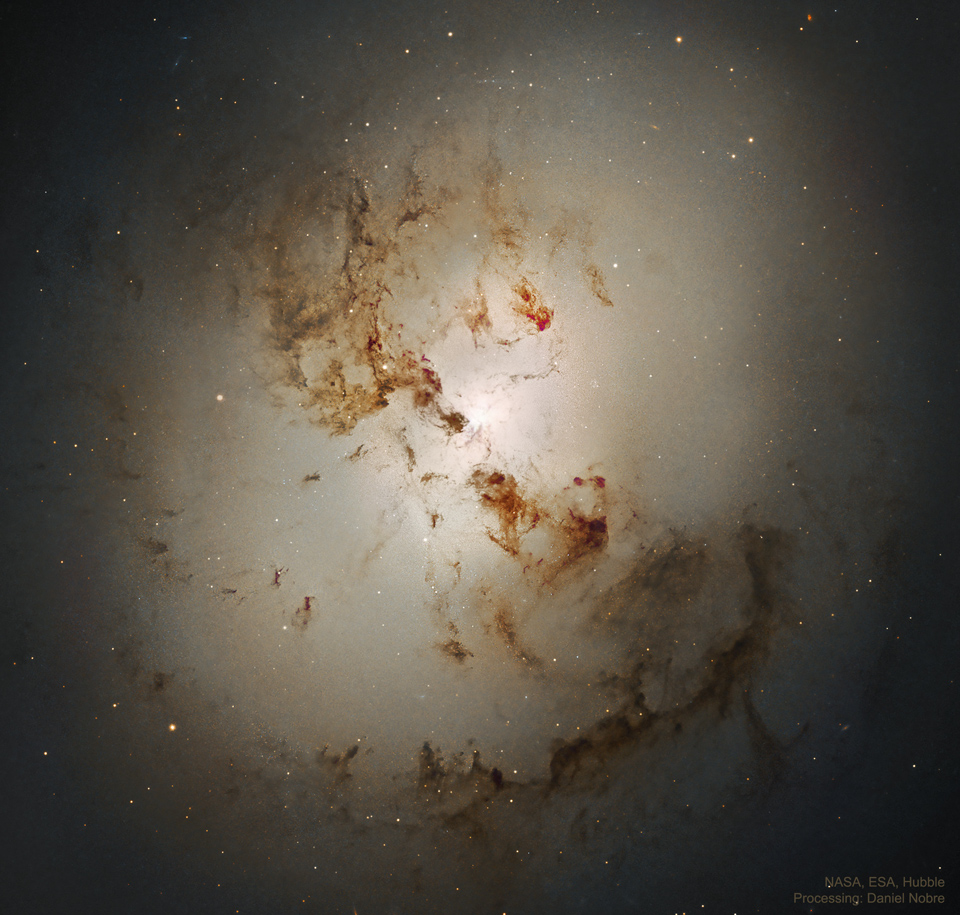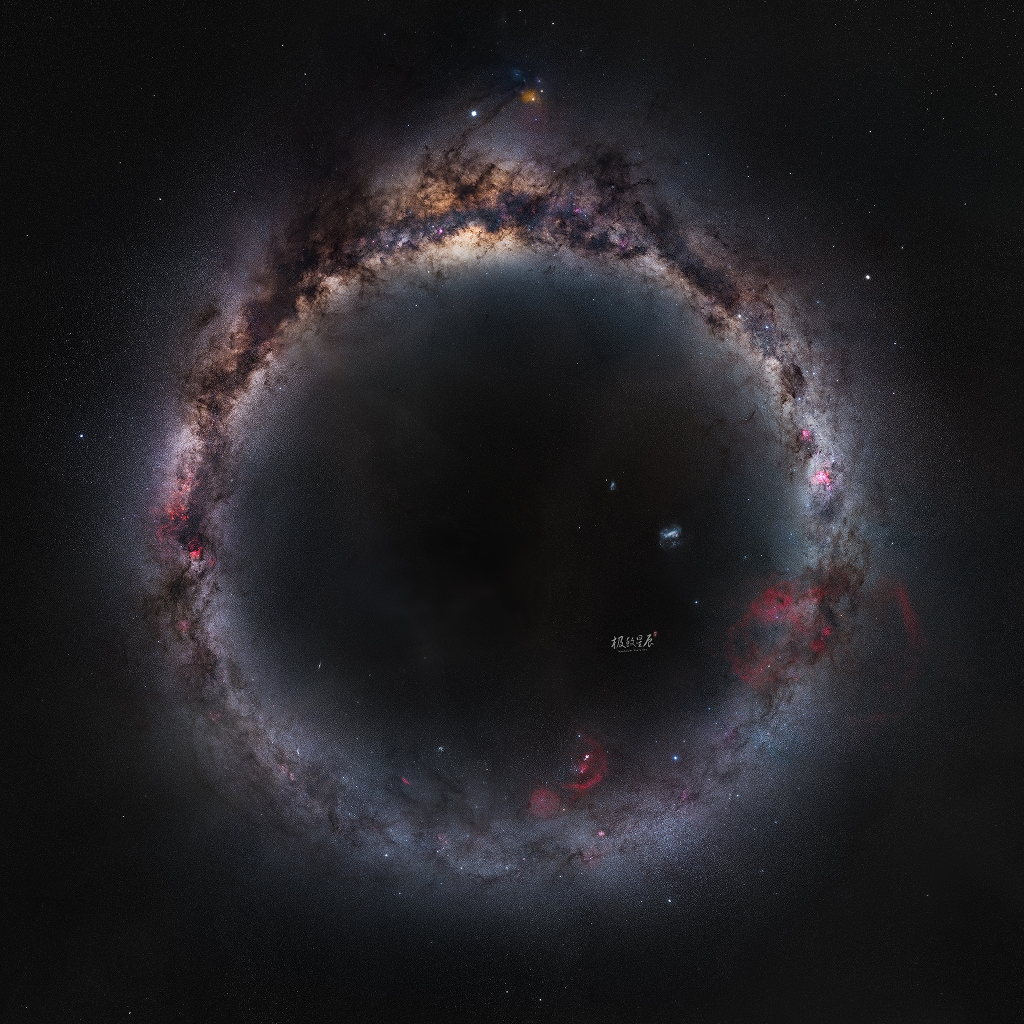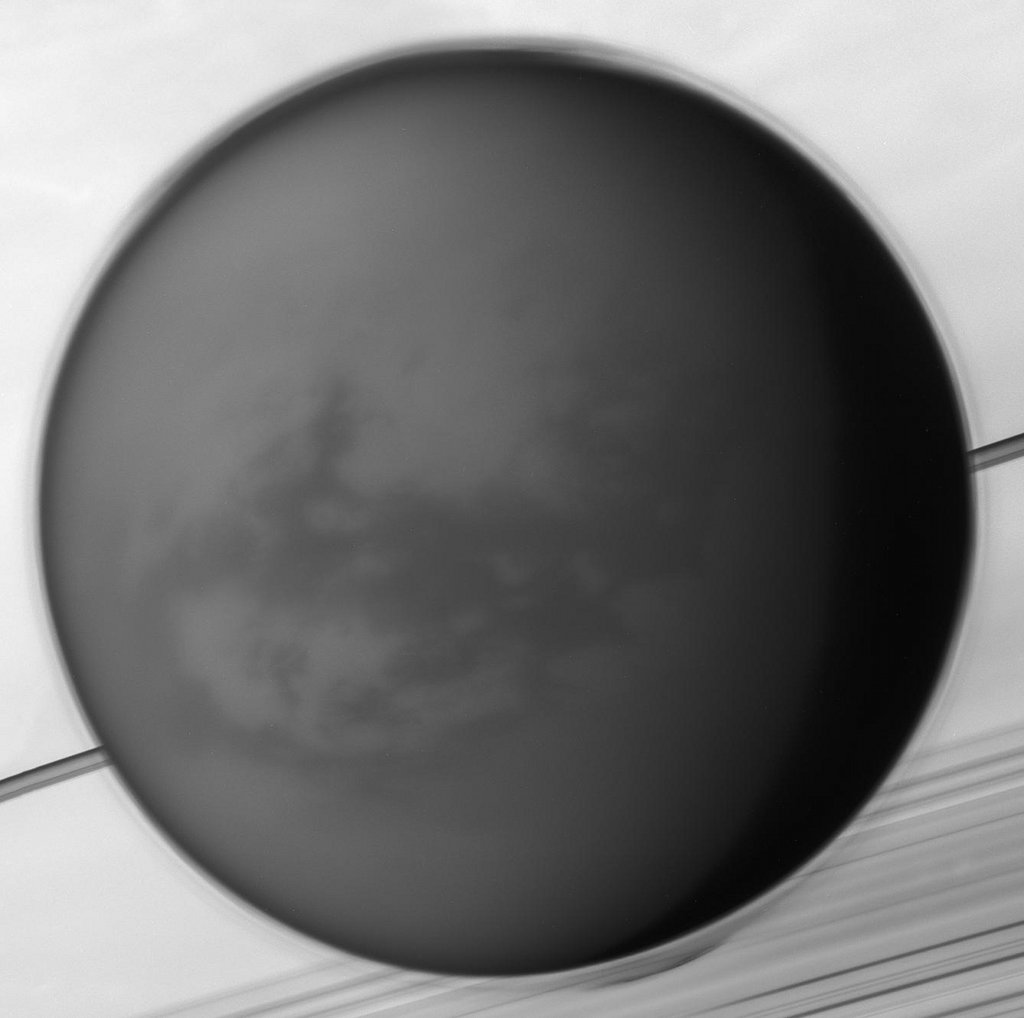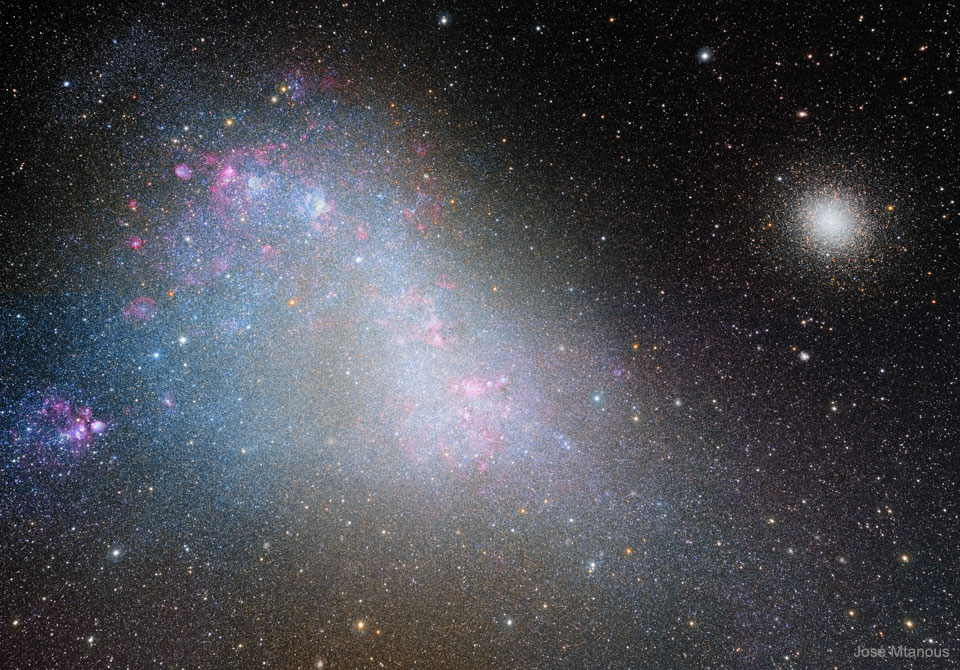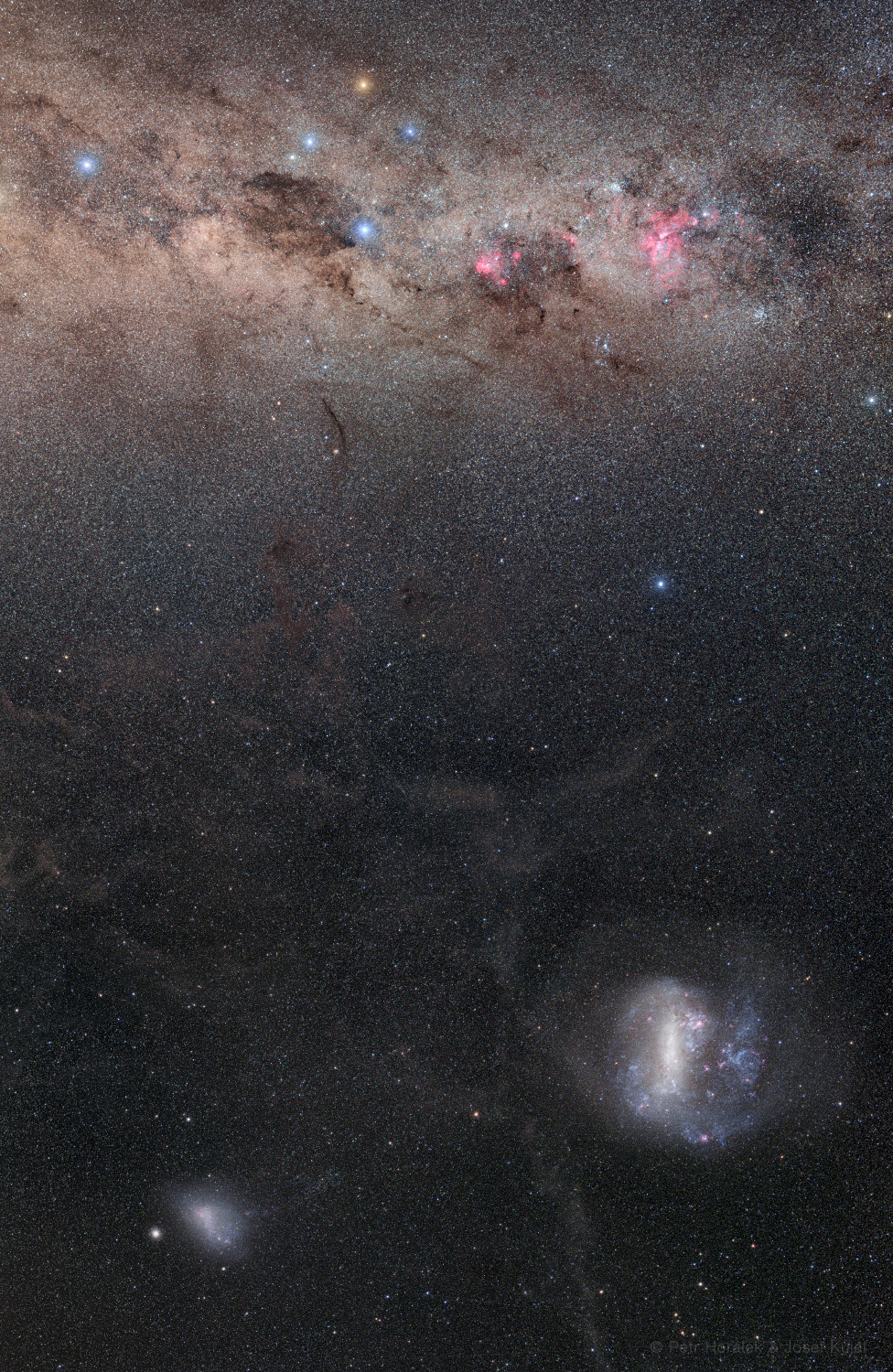Nombre total de pages vues
29/01/2021
ASTRONOMIA - Lua colorida
27/01/2021
ASTRONOMY - The Vertical Magnetic Field of NGC 5775
2021 January 27
Image Credit: NRAO, NASA, ESA, Hubble; Processing & Text: Jayanne English (U. Manitoba)
Explanation: How far do magnetic fields extend up and out of spiral galaxies? For decades astronomers knew only that some spiral galaxies had magnetic fields. However, after NRAO's Very Large Array (VLA) radio telescope (popularized in the movie Contact) was upgraded in 2011, it was unexpectedly discovered that these fields could extend vertically away from the disk by several thousand light-years. The featured image of edge-on spiral galaxy NGC 5775, observed in the CHANG-ES (Continuum Halos in Nearby Galaxies) survey, also reveals spurs of magnetic field lines that may be common in spirals. Analogous to iron filings around a bar magnet, radiation from electrons trace galactic magnetic field lines by spiraling around these lines at almost the speed of light. The filaments in this image are constructed from those tracks in VLA data. The visible light image, constructed from Hubble Space Telescope data, shows pink gaseous regions where stars are born. It seems that winds from these regions help form the magnificently extended galactic magnetic fields.
26/01/2021
ASTRONOMY - Central NGC 1316: After Galaxies Collide
2021 January 26
Image Credit: NASA, ESA, Hubble; Processing & Copyright: Daniel Nobre
Explanation: How did this strange-looking galaxy form? Astronomers turn detectives when trying to figure out the cause of unusual jumbles of stars, gas, and dust like NGC 1316. Inspection indicates that NGC 1316 is an enormous elliptical galaxy that somehow includes dark dust lanes usually found in a spiral galaxy. Detailed images taken by the Hubble Space Telescope shows details, however, that help in reconstructing the history of this gigantic tangle. Deep and wide images show huge collisional shells, while deep central images reveal fewer globular clusters of stars toward NGC 1316's interior. Such effects are expected in galaxies that have undergone collisions or merging with other galaxies in the past few billion years. The dark knots and lanes of dust, prominent in the featured image, indicate that one or more of the devoured galaxies were spiral galaxies. NGC 1316 spans about 50,000 light years and lies about 60 million light years away toward the constellation of the Furnace (Fornax).
23/01/2021
ASTRONOMY - The Milky Ring
2021 January 23
Image Credit & Copyright: Alvin Wu
Explanation: An expanse of cosmic dust, stars and nebulae along the plane of our Milky Way galaxy form a beautiful ring in this projected all-sky view. The creative panorama covers the entire galaxy visible from planet Earth, an ambitious 360 degree mosaic that took two years to complete. Northern hemisphere sites in western China and southern hemisphere sites in New Zealand were used to collect the image data. Like a glowing jewel set in the milky ring, the bulge of the galactic center, is at the very top. Bright planet Jupiter is the beacon just above the central bulge and left of red giant star Antares. Along the plane and almost 180 degrees from the galactic center, at the bottom of the ring is the area around Orion, denizen of the northern hemisphere's evening winter skies. In this projection the ring of the Milky Way encompasses two notable galaxies in southern skies, the large and small Magellanic clouds.
AERONAUTIQUE - L’avion avec cabine éjectable
16/01/2021
ASTRONOMY - The Mountains of NGC 2174
2021 January 16
Image Credit: NASA, ESA, Hubble Heritage Team (STScI/AURA)
Explanation: This fantastic skyscape lies near the edge of NGC 2174 a star forming region about 6,400 light-years away in the nebula-rich constellation of Orion. It follows mountainous clouds of gas and dust carved by winds and radiation from the region's newborn stars, now found scattered in open star clusters embedded around the center of NGC 2174, off the top of the frame. Though star formation continues within these dusty cosmic clouds they will likely be dispersed by the energetic newborn stars within a few million years. Recorded at infrared wavelengths by the Hubble Space Telescope in 2014, the interstellar scene spans about 6 light-years. Scheduled for launch in 2021, the James Webb Space Telescope is optimized for exploring the Universe at infrared wavelengths.
13/01/2021
ASTRONOMY - Arches Across an Arctic Sky
2021 January 13
Image Credit & Copyright: Giulio Cobianchi
Explanation: What are these two giant arches across the sky? Perhaps the more familiar one, on the left, is the central band of our Milky Way Galaxy. This grand disk of stars and nebulas here appears to encircle much of the southern sky. Visible below the stellar arch is the rusty-orange planet Mars and the extended Andromeda galaxy. For a few minutes during this cold artic night, a second giant arch appeared to the right, encircling part of the northern sky: an aurora. Auroras are much closer than stars as they are composed of glowing air high in Earth's atmosphere. Visible outside the green auroral arch is the group of stars popularly known as the Big Dipper. The featured digital composite of 18 images was captured in mid-December over the in Norway.
11/01/2021
ASTRONOMY - Moon Phases in 2021
2021 January 11
Video Credit: Data: Lunar Reconnaissance Orbiter ; Animation: NASA's Scientific Visualization Studio;
Music: Brandenburg Concerto No4-1 BWV1049 (Johann Sebastian Bach), by Kevin MacLeod via Incompetech
Explanation: What will the Moon phase be on your birthday this year? It is hard to predict because the Moon's appearance changes nightly. As the Moon orbits the Earth, the half illuminated by the Sun first becomes increasingly visible, then decreasingly visible. The featured video animates images taken by NASA's Moon-orbiting Lunar Reconnaissance Orbiter to show all 12 lunations that appear this year, 2021. A single lunation describes one full cycle of our Moon, including all of its phases. A full lunation takes about 29.5 days, just under a month (moon-th). As each lunation progresses, sunlight reflects from the Moon at different angles, and so illuminates different features differently. During all of this, of course, the Moon always keeps the same face toward the Earth. What is less apparent night-to-night is that the Moon's apparent size changes slightly, and that a slight wobble called a libration occurs as the Moon progresses along its elliptical orbit.
10/01/2021
AERONAUTIQUE - L’avion transparent alimenté par votre chaleur corporelle
09/01/2021
ASTRONOMY - Titan: Moon over Saturn
2021 January 9
Image Credit: NASA, JPL-Caltech, Space Science Institute
Explanation: Like Earth's moon, Saturn's largest moon Titan is locked in synchronous rotation. This mosaic of images recorded by the Cassini spacecraft in May of 2012 shows its anti-Saturn side, the side always facing away from the ringed gas giant. The only moon in the solar system with a dense atmosphere, Titan is the only solar system world besides Earth known to have standing bodies of liquid on its surface and an earthlike cycle of liquid rain and evaporation. Its high altitude layer of atmospheric haze is evident in the Cassini view of the 5,000 kilometer diameter moon over Saturn's rings and cloud tops. Near center is the dark dune-filled region known as Shangri-La. The Cassini-delivered Huygens probe rests below and left of center, after the most distant landing for a spacecraft from Earth.
07/01/2021
ASTRONOMY - Total Solar Eclipse 2020
2021 January 7
Image Credit & Copyright: Miloslav Druckmuller, Andreas Moller, (Brno University of Technology),
Explanation: Along a narrow path crossing southern South America through Chile and Argentina, the final New Moon of 2020 moved in front of the Sun on December 14 in the year's only total solar eclipse. Within about 2 days of perigee, the closest point in its elliptical orbit, the New Moon's surface is faintly lit by earthshine in this dramatic composite view. The image is a processed composite of 55 calibrated exposures ranging from 1/640 to 3 seconds. Covering a large range in brightness during totality, it reveals the dim lunar surface and faint background stars, along with planet-sized prominences at the Sun's edge, an enormous coronal mass ejection, and sweeping coronal structures normally hidden in the Sun's glare. Look closely for an ill-fated sungrazing Kreutz family comet (C/2020 X3 SOHO) approaching from the lower left, at about the 7 o'clock position. In 2021 eclipse chasers will see an annular solar eclipse coming up on June 10. They'll have to wait until December 4 for the only total solar eclipse in 2021 though. That eclipse will be total along a narrow path crossing the southernmost continent of Antarctica.
05/01/2021
ASTRONOMY - The Small Cloud of Magellan
2021 January 5
Image Credit & Copyright: José Mtanous
Explanation: What is the Small Magellanic Cloud? It has turned out to be a galaxy. People who have wondered about this little fuzzy patch in the southern sky included Portuguese navigator Ferdinand Magellan and his crew, who had plenty of time to study the unfamiliar night sky of the south during the first circumnavigation of planet Earth in the early 1500s. As a result, two celestial wonders easily visible for southern hemisphere skygazers are now known in Western culture as the Clouds of Magellan. Within the past 100 years, research has shown that these cosmic clouds are dwarf irregular galaxies, satellites of our larger spiral Milky Way Galaxy. The Small Magellanic Cloud actually spans 15,000 light-years or so and contains several hundred million stars. About 210,000 light-years away in the constellation of the Tucan (Tucana), it is more distant than other known Milky Way satellite galaxies, including the Sagittarius Dwarf galaxy and the Large Magellanic Cloud. This sharp image also includes the foreground globular star cluster 47 Tucanae on the right.
04/01/2021
AERONAUTIQUE - Vacances au Pole
Se prélasser à côté des ours polaires pour les vacances, un rêve à la portée de tous en l'an 2000 ! Enfin, c'est ce que l'on croyait dans les années 1900. Des ballons gonflants auraient emmené de larges paquebots flottants vers la destination glacée. On imagine que le chauffage était intégré aux plans du navire !
© Hildebrands
03/01/2021
ASTRONOMY - A Phoenix Aurora over Iceland
2021 January 3
Image Credit & Copyright: Hallgrimur P. Helgason; Rollover Annotation: Judy Schmidt
Explanation: All of the other aurora watchers had gone home. By 3:30 am in Iceland, on a quiet September night, much of that night's auroras had died down. Suddenly, unexpectedly, a new burst of particles streamed down from space, lighting up the Earth's atmosphere once again. This time, surprisingly, pareidoliacally, the night lit up with an amazing shape reminiscent of a giant phoenix. With camera equipment at the ready, two quick sky images were taken, followed immediately by a third of the land. The mountain in the background is Helgafell, while the small foreground river is called Kaldá, both located about 30 kilometers north of Iceland's capital Reykjavík. Seasoned skywatchers will note that just above the mountain, toward the left, is the constellation of Orion, while the Pleiades star cluster is also visible just above the frame center. The 2016 aurora, which lasted only a minute and was soon gone forever -- would possibly be dismissed as an fanciful fable -- were it not captured in the featured, digitally-composed, image mosaic.
02/01/2021
SPACE ART - Saturne vue de Titan
Si Lucien Rudaux est considéré comme le “grand-père” du Space art, Chelsey Bonestell est bien le père de la discipline. L’Américain a démarré sa carrière comme architecte, en participant notamment à l’élaboration de la façade du Chrysler Building à New York ou du bâtiment de la Cour suprême des États-Unis. Il se spécialise ensuite dans les effets spéciaux à Hollywood, par exemple pour les films Le bossu de Notre-Dame (1939) ou Citizen Kane (1941).
Toutefois, passionné depuis toujours par l’astronomie, Chesley Bonestell décide d’utiliser ses compétences afin de créer des œuvres entrant dans la catégorie du Space art. Ainsi, il s’inspire très largement de Lucien Rudaux, et associe miniatures d’argile, astuces photographiques et techniques de peinture pour élaborer des tableaux au réalisme saisissant. C’est en 1944 dans le magazine Life que paraît sa première grande réalisation : une série de représentations de Saturne vue de ses lunes.

ASTRONOMY - 21st Century Wet Collodion Moon
2021 January 2
Image Credit & Copyright: Mike Smolinsky
Explanation: In the mid 19th century, one of the first photographic technologies used to record the lunar surface was the wet-plate collodion process, notably employed by British astronomer Warren De la Rue. To capture an image, a thick, transparent mixture was used to coat a glass plate, sensitized with silver nitrate, exposed at the telescope, and then developed to create a negative image on the plate. To maintain photographic sensitivity, the entire process, from coating to exposure to developing, had to be completed before the plate dried, in a span of about 10 to 15 minutes. This modern version of a wet-plate collodion image celebrates lunar photography's early days, reproducing the process using modern chemicals to coat a glass plate from a 21st century hardware store. Captured last November 28 with an 8x10 view camera and backyard telescope, it faithfully records large craters, bright rays, and dark, smooth mare of the waxing gibbous Moon. Subsequently digitized, the image on the plate was 8.5 centimeters in diameter and exposed while tracking for 2 minutes. The wet plate's effective photographic sensitivity was about ISO 1. In your smart phone, the camera sensor probably has a photographic sensitivity range of ISO 100 to 6400 (and needs to be kept dry ...).
01/01/2021
ASTRONOMY - Galaxies and the South Celestial Pole
2021 January 1
Image Credit & Copyright: Petr Horalek, Josef Kujal
Explanation: The South Celestial Pole is easy to spot in star trail images of the southern sky. The extension of Earth's axis of rotation to the south, it's at the center of all the southern star trail arcs. In this starry panorama streching about 60 degrees across deep southern skies the South Celestial Pole is somewhere near the middle though, flanked by bright galaxies and southern celestial gems. Across the top of the frame are the stars and nebulae along the plane of our own Milky Way Galaxy. Gamma Crucis, a yellowish giant star heads the Southern Cross near top center, with the dark expanse of the Coalsack nebula tucked under the cross arm on the left. Eta Carinae and the reddish glow of the Great Carina Nebula shine along the galactic plane near the right edge. At the bottom are the Large and Small Magellanic clouds, external galaxies in their own right and satellites of the mighty Milky Way. A line from Gamma Crucis through the blue star at the bottom of the southern cross, Alpha Crucis, points toward the South Celestial Pole, but where exactly is it? Just look for south pole star Sigma Octantis. Analog to Polaris the north pole star, Sigma Octantis is little over one degree fom the the South Celestial pole.
ASTRONOMY - NanoSail-D2
2026 January 2 NanoSail-D2 Image Credit & Copyright : Ralf Vandebergh Explanation: In 2011, on January 20, NASA's NanoSail-D2 ...
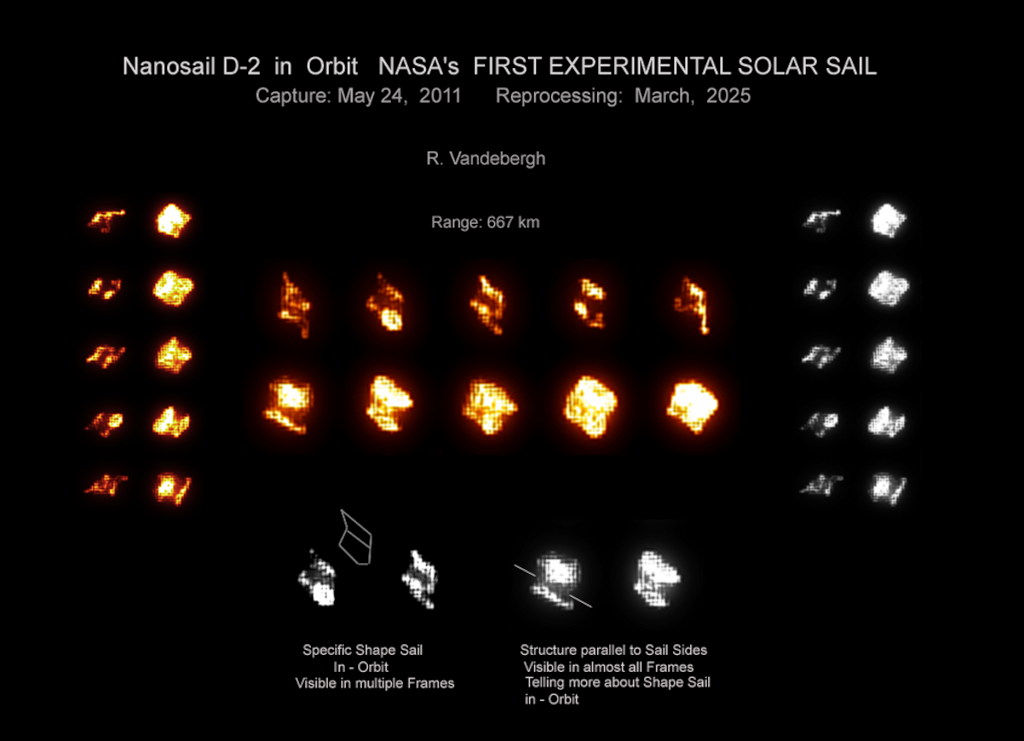
-
2022 September 26 All the Water on Planet Earth Illustration Credit: Jack Cook, Adam Nieman, Woods Hole Oceanographic Institution ; Data ...
-
2025 May 11 The Surface of Venus from Venera 14 Image Credit: Soviet Planetary Exploration Program , Venera 14 ; Processing & Copyri...


